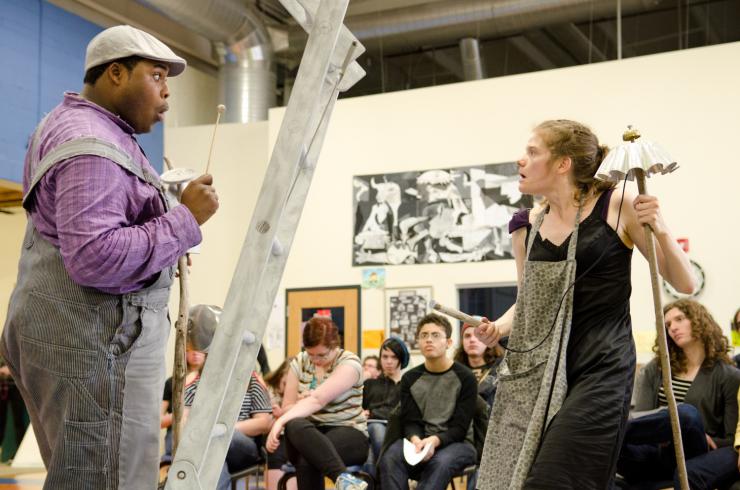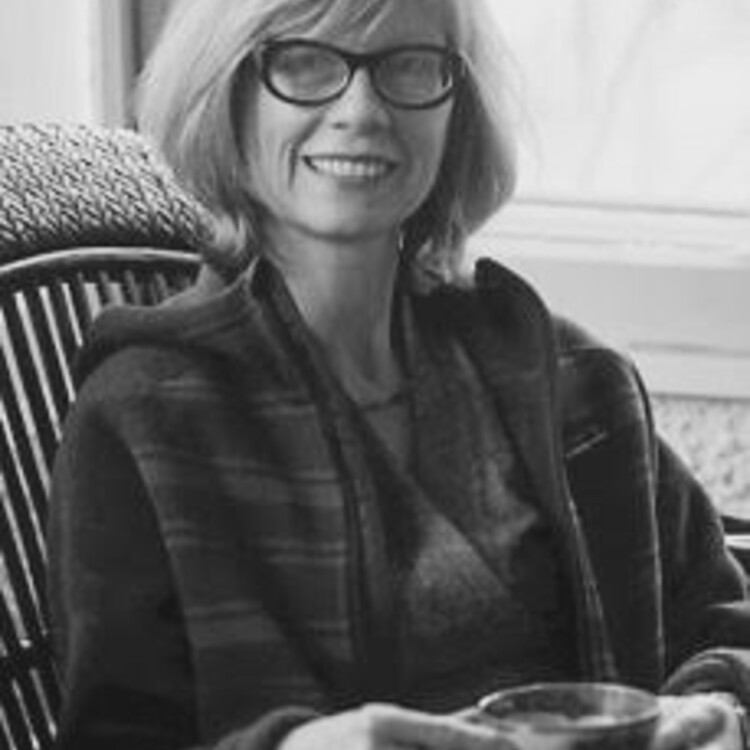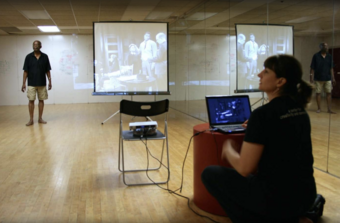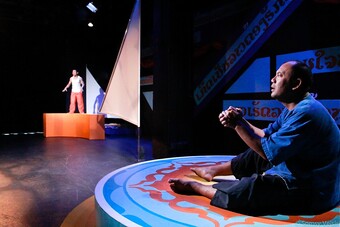Ten Thousand Things & Kira Obolensky
A Long-term Playwright Residency Model
Playwright Kira Obolensky and Artistic Director of Ten Thousand Things Michelle Hensley are two fierce artists building a creative partnership. In 2013 Kira was awarded one of fourteen Andrew W. Mellon residencies to work with Ten Thousand Things. These Andrew W. Mellon residencies are designed to have a playwright on staff at a theatre for three years. I have been given the opportunity to document this residency for its duration—examining the residency’s impact on both Kira and Ten Thousand Things.
As soon as Kira received the residency she began working on a new play, Dirt Sticks, an imaginative and magical tale about a young man, Henry Wand, who has lost his parents and is being raised by his grandmother. Through the course of the play Henry learns about his past and begins to imagine the possibility of what lies ahead for him. Dirt Sticks was at the heart of Michelle and Kira’s work together in this first year of the residency. In addition to being the artistic director of Ten Thousand Things, Michelle often directs for the company, and with Dirt Sticks, Michelle served in both capacities. Here’s an inside look into the first year of this residency using the development of Dirt Sticks as context.

Background
Ten Thousand Things has been producing plays in non-theatre venues in the Twin Cities since 1992, and is well respected for the high quality of its performances. The mission of the organization is to bring theatre to communities that do not generally have the opportunity to experience theatre. Bringing free theatre to prisons, homeless shelters, and community centers is the hallmark of the company’s mission; however, Ten Thousand Things also presents a handful of paid performances for general theatregoers. (These paid performances usually sell out before they start performing because of the theatre’s loyal following.)
Prior to being the playwright in residence, Kira had already been commissioned to write two plays for Ten Thousand Things. One was an adaptation of Dostoevsky’s Crime and Punishment entitled Raskol, produced in 2009. The other was based on a Russian fairytale, whose central character is also the title for the play, Vasa Lisa, which was produced in 2012. Dirt Sticks is the first completely original play Kira has written for the company, and it was her idea to begin her residency by writing an original story.
Residency
What does “residency” at Ten Thousand Things mean when the theatre is, by design, transient in nature and the company doesn’t have an office? It means that the playwright/artistic director relationship is rooted in a familial environment. Michelle and her small staff work out of their homes, which keeps the company nimble and the overhead cost extremely low. Most meetings take place in Michelle’s living room. Kira comes over and they discuss the organization’s goals and artistic ambitions over coffee. They also laugh a lot; their shared sense of humor is one of the elements of synergy between them.
The informal nature of their workspace sets the tone for their relationship with each other and the artists with whom they work. Although they rehearse in a church (across the street from Michelle’s house) they sometimes gather with actors to hear a script in a domestic setting. An early draft of Dirt Sticks was read at a dinner gathering at Kira’s house. Michelle and Kira concur that eating a meal with a cast helps create a sense of artistic community.
Commitment
As part of the application, Kira and Michelle were required to submit a proposal describing how this residency would manifest. Their residency was designed with the commitment that Kira would write three plays for the theatre, and Ten Thousand Things, in turn, would produce those three plays.
Kira had a relationship with the Ten Thousand Things, but once she received the residency, she became even more intent on getting to know her audience. She began following the company around from homeless shelter, to prison, to detox center, watching performances of other plays they produced such as A Midsummer Night’s Dream and The Music Man.
The residency has enabled Kira to significantly reduce her teaching load and focus more specifically on her work for Ten Thousand Things, allowing her to have more time to write. Neither Kira nor Michelle could have predicted the alacrity with which Kira would write these commissioned plays. Now a little over a year into the residency, Dirt Sticks is in production, Kira has a solid draft of her second play, and she has clear ideas about how she will be approaching her third play. The speed at which Kira is writing can be attributed to the time the residency has afforded her, the passion she has developed for the company, and her assurance that these plays will be produced in a timely fashion.
Long-term commitment is a key element to the success of this residency, and this commitment is shared by the playwright, the theatre, and the foundation. Kira has committed to creating work with Ten Thousand Things in mind, Michelle has committed to producing that work, and the Andrew W. Mellon Foundation has committed to funding the residency for three years. The three-year period gives the collaborators and the collaboration sufficient time and focus to build a body of work and a shared experience of the theatre.
Long-term commitment is a key element to the success of this residency, and this commitment is shared by the playwright, the theatre, and the foundation.
Defining Shared Vision
What type of play works best for Ten Thousand Things? This is a question that Kira has been intently pondering.
There's a kind of story that does work for Ten Thousand Things—and that story I would define as stretchy, that is to say, it asks questions that various people in various audiences can identify with; I think it is told sparingly and often with a blurred background, in the sense that it's the characters that create the world, not a specific place."
Michelle agrees with Kira’s assessment.
Yes, we find ourselves drawn to stories set in another time, another place—a world no one of any particular class or background can be an expert in, a world we can all make up together. I enjoy making up worlds, and Kira does too. I think our audiences do as well.
They’ve termed these plays “fairytales” because the plays offer an imagined world based in emotional truth. The world created invites everyone to enter the story on equal footing; since everyone is unfamiliar with the world, no one is an expert. A Ten Thousand Things play also allows for diverse casting choices. For example, although a family story is at the heart of Dirt Sticks, there was no need to have family members look alike. The play functions on its own terms and is not bound to the logic of naturalism.
Over the years Ten Thousand Things has produced many classics and fewer new plays. Michelle attributes this to the fact that the new plays she encounters are often small in scope and specific to place and circumstance, which is not the type of story Ten Thousand Things aims to tell. Having Kira on staff as a writer-in-residence for three years guarantees three new plays will be created in conversation with the Ten Thousand Things audience. Michelle says, “I think what Kira does is imagine an enormous audience, reaching far beyond the ‘specific’ upper middle class audience that many playwrights seem to write for without even realizing it,” and this is one of the reasons she sought out Kira as the first writer-in-residence for the company.
Writing for Ten Thousand Things
When Kira originally set out to write Dirt Sticks, she thought she was going to write about the suffragette movement; however as she got into it, she felt as if that story was too specific. Then she started to write about female millworkers. Again, she found the lens of the story to be too narrow. When writing Dirt Sticks, she combined some ideas from those initial impulses, namely, what it’s like to be stuck in a job or trapped by your given circumstances, but then went broader to create an even more fictional world.
In May of 2013, Kira went on a retreat and came back with a draft of Dirt Sticks that she felt was too serious and almost realistic. Emblematic of Kira’s aesthetic, and in particular her work for Ten Thousand Things, is a sense of playfulness. Shortly after her retreat, Kira discovered a traditional folk song online about an old woman and a devil that offered inspiration and helped her consider a new framework for the play. Kira decided to create her own chant that served as connective tissue for the story, and helped define the broader theatrical landscape.
Dirt Sticks is set in Ladder Town. And as the characters in the play state:
People climb up. People climb down
Let’s look at the then, and consider the now
People go up, people go down
The way it goes in Ladder Town
In addition to the chant, which expands the landscape and emboldens the theatricality, Kira began to add story elements that were in conversation with Ten Thousand Things’ specific aesthetic requirements. Inspired by the ways in which Michelle problem solves as a director, Kira built in challenges that Michelle could artfully interpret. For example, Ten Thousand Things always performs with the lights on and without theatrical instruments, and Dirt Sticks takes place during the time of the perigee moon—when the moon is closest to the earth. Ten Thousand Things uses minimal set elements that need to travel to various facilities, and in this case those simple elements were ladders—Dirt Sticks takes place in a town that makes ladders. Verticality is an important part of the text’s imagery and is inherent in the action of the play.
Kira and Michelle had two workshops of Dirt Sticks at the Playwrights’ Center. The first workshop was in June of 2013, and it allowed Kira to define the characters’ journeys and consider how the chant and percussive elements might be used in the play. Since Ten Thousand Things performs with few, if any technical elements, live sound often becomes an important aspect of the performance, and Kira wanted to write rhythm into the text.
The second workshop was in December 2013. In this workshop she was able to clarify and simplify the story. Through her work at Ten Thousand Things Kira has observed her writing becoming clearer. This streamlined storytelling doesn’t mean her plays are more realistic; it means that they are easier to track since she eliminates anything that might be extraneous.
The December workshop culminated with a public reading. Sitting amidst an audience allows Kira to observe if the audience leans in or becomes restless. “Audiences are great clarifiers! They allow me to hear everything that may be self indulgent or unclear. I left that workshop with another round of revisions to do.”
Michelle was an important asset to the revision process as well. “Her clarity is so useful and helpful to me,” remarked Kira. “Because she has such familiarity with the Ten Thousand Things’ audience, I feel like her comments really help me clarify and clarify and clarify.”
This sense of continuum is one of the most significant benefits of the residency. It allows these two artists to work together and deepen their relationship over time.
The Continuum
“I think there is a certain ease and comfort and lack of stress to everything we do now because we sense the luxury of having three years to work together, and are able to see everything more in terms of a continuum,” noted Michelle.
This sense of continuum is one of the most significant benefits of the residency. It allows these two artists to work together and deepen their relationship over time. Additionally, Kira is able to engage with Ten Thousand Things beyond her role as playwright. She serves as the social media manager and teaches writing classes to inmates. This engagement provides greater context for Kira’s work and allows her to connect in other ways with Ten Thousand Things’ audience.
As Michelle and Kira headed into performances of Dirt Sticks across the Twin Cities—from the Dorothy Day Center homeless shelter to the Ramsey County Correctional Facility—it is clear that their work is a product of a considered partnership—both with each other and the communities they serve. And what is next in the continuum for these women? The New Don Juan is Kira’s second residency commission, a tragic comedy that examines what happens to those who are left behind during wartime, and what a romance between a man and a woman might be like in a truly equal society. Michelle has already committed to producing the play next season.
Over the past year I have observed that the success of this residency lives in the partnership that Kira and Michelle continue to develop. This partnership is based on shared commitment and vision. The underlying element is the gift of time—time that allows for an intensive focus on the writing, getting to know the audience for whom she is writing, and time that allows for deep and continuous conversation between playwright and artistic director.













Comments
The article is just the start of the conversation—we want to know what you think about this subject, too! HowlRound is a space for knowledge-sharing, and we welcome spirited, thoughtful, and on-topic dialogue. Find our full comments policy here
A fascinating and inspiring article. I can't help but think the theatre will grow healthier if there are more plays written for "an enormous audience." I want to see these plays!
I love the specificity of Ten Thousand Things' focus and what an extraordinary pairing it is with Kira's work. Only great things can come of this!